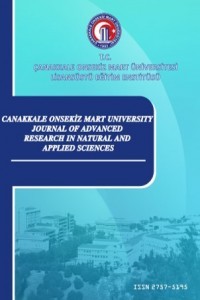Bahçe AtÄąklarÄą Kompostunun Yasal DÞzenlemeler Ãerçevesinde Toprak ÅartlandÄąrÄącÄąsÄą Olarak KullanÄąmÄąnÄąn Ä°ncelenmesi
: Bahçe atÄąklarÄą, Geri dÃķnÞÅÞm, KatÄą atÄąk, Kompost, Toprak dÞzenleyici, SÞrdÞrÞlebilirlik
Investigation of the Potential Use of Yard Waste Compost as a Soil Conditioner
Yard waste, Recycle, Solid waste, Compost, Soil amendment, Sustainability,
___
- Banegas, V., Moreno, J.L., Moreno, J.I., Garcia, C., Leon, G., Hernandez, T., 2007. Composting anaerobic and aerobic sewage sludges using two proportions of sawdust. Waste Manage. 27, 1317â1327.
- Bertoldi, M., Valini, G., and Pera, A., 1983. The biology of composting, Waste Manage. Res., 1, 157-176.
- Brady N., Weil R., 1996. The Nature and properties of Soils, 12th ed. Prentice, New Jersey, USA. 385-495.
- DÞzenli Depolama YÃķnergesi 1999. Avrupa BirliÄi, 1999/31/EC.
- Epstein, E., 1997. The Science of Composting, Technomic Publishing Co., Inc., Lancaster, Basel.
- Graves, R. E., Hattemer, G.M., 2000. Composting, Chapter 2, Environmental Engineering National Engineering Handbook, United States Department of Agriculture, Natural Resources Conservation Service.
- Himanen, M., Hanninen, K., 2011. Composting of bio-waste, aerobic and anaerobic sludges â effect of feedstock on the process and quality of compost. Bioresour. Technol. 102, 2842â2852.
- Hirai, M.F., Chanyasak, V., Kubota, H., 1983. A standard method for measurement of compost maturity. Bio Cycles 24, 54â56.
- Huang G. F., Wu Q. T., Wong J. W. C., Nagar B. B., 2006. Transformation of organic matter during co-composting of pig manure with sawdust. Bioresour. Technol. 97, 1834- 1842.
- Ä°nce O., Ãzbayran E. G., Akyol Ã., Ä°nce Ã., Ä°nce B. 2015. Composting practice for sustainable waste management: a case study in Istanbul, Desalination and Water Treatment, DOI: 10.1080/19443994.2015.1067170.
- Insam H, de Bertoldi M. 2003. Microbiology of the composting process. In: Golueke C., Bidlingmaier W., de Bertoldi M., Diaz L., Eds, Compost Science and Technology, Elsevier Science Ltd. 25-47.
- Jayasree S., Balan Ranjini 2012. Characterization and bacterial succession studies of garden waste during the windrow composting process at Mercy College Campus. Biochem. Cell. Arch. Vol:12, No.2 : 403-413.
- Kompost TebliÄi 2015, Ãevre ve Åehircilik BakanlÄąÄÄą, Resmi Gazete,5 Mart 2015.
- Lá―đpez-GonzÃĄlez J. A., SuÃĄrez-Estrella F., Vargas-Garcia M. C., Lá―đpez M. J., Jurado M. M., Moreno J. 2015. Dynamics of bacterial microbiota during lignocellulosic waste composting: Studies upon its structure, functionality and bio diversity. Bioresourse Technology 175: 406-416.
- Mc Cartney, D., Tingley, J., 1998. Development of a rapid moisture content method for compost materials. Compost Sci. Util., 6, 14-25.
- Mc Kinley, V.L., Vestal, J.R., Eralp, A.E.,1985. Microbial activity in composting, Biocycle, 26 (6): 39-43.
- Mohee R., Soobhany N., 2014. Comparison of heavy metals content in compost against vermicompost of organic solid waste: Paste and present, Resour. Conserv. Recy. 92: 206-2013
- Nadia Farah O.F., Xiang L.Y., Lie L. Y., Anuar Chairil D. C., Afandi M. P. M., Baharuddin S. A. 2015. Investigation of physico-chemical properties and microbial communityduring poultry manure co-composting process, J. Environ. Sci. 28:81-94.
- ÃzbaÅ E. E., Balkaya N., EmÄąk S., 2011. Ham kompost ve ekstraksiyon iÅlemine tabi tutulmuÅ kompost numunelerinin karakterizasyonlarÄą ve bitkiye yarayÄąÅlÄąklarÄą aÃ§ÄąsÄąndan karÅÄąlaÅtÄąrÄąlmasÄą, Ekoloji, 79, 45-56
- Pichtel J., Anderson M., 1997. Trace metal bioavailability in municipal solid waste and sewage sludge composts. Bioresour. Tech. 60: 223-229.
- Pinamonti F, Stringari G., Gasperi F., Zorzi G., 1997. The Use of Compost:its effects on heavy metal levels in soil and plants. Resources, Conservation and Recycling 21: 129-143.
- Rynk, R., Kamp, M., Richard, T., Klega J.,Gouin, F.,1992. On Farm Composting Handbook. Northeast Regional Agricultural Engineering Service, 152. Rile- Robb Hall, Cooperative Extension, Ithaca, N.Y. 14853-5701, USA.
- Sharma, V.K., Canditelli, F. Fortuna and G. Cornacchia, 1997. Processing of urban and agro-industrial residues by aerobic composting: Review, Energy Convers. Mgmt., 38 (5) , 453-478.
- Smith S. R., 2009. A critical review of the bioavailability and impacts of heavy metals in municipal solid waste composts compared to sewage sludge. Environ. Intern. 35: 142-156.
- Stentiford, E.I., 1996. Composting control: principles and practice. In: de Bertoldi, M., Sequi, P., Lemmes, B., Papi, T. (Eds.), The Science of Composting: Part I:Chapman and Hall Inc., London, pp. 49-59.
- Suler , D.J., Finstein, M.S., 1977. Effect of temperature, aeration and moisture on CO2 formation in bench-scale, continuously thermophilic composting of solid waste. Appl. Environ. Microbiol., 33, 345-350.
- TarÄąmda KullanÄąlan Organik, Organomineral GÞbreler ve Toprak DÞzenleyiciler Ä°le Mikrobiyal, Enzim İçerikli ve Organik KaynaklÄą DiÄer ÃrÞnlerin Ãretimi, Ä°thalatÄą, Ä°hracatÄą ve Piyasaya ArzÄąna Dair YÃķnetmelik 2014, Ãevre ve Åehircilik BakanlÄąÄÄą, Resmi Gazete, 28956, 29 Mart 2014
- Tiquia S. M., Tam N. F. Y., Hodgkis I. J. 1996.Effect of composting on phytotoxicity of spent pig-manure sawdust litter. Environ. Pollut. 93: 249-256.
- YayÄąn AralÄąÄÄą: YÄąlda 4 SayÄą
- BaÅlangÄąÃ§: 2015
- YayÄąncÄą: Ãanakkale Onsekiz Mart Ãniversitesi
Sentetik GÞbre YÞkleme ve SalÄąm İçin Hidrojel-Kil Kompozitleri
Nurettin ÅAHÄ°NER, Åahin DEMÄ°RCÄ°, Duygu ALPARSLAN, Tugba ERSEN DUDU, Nahit AKTAÅ, Ãmer Faruk ÃZTÃRK
Zeytin Karasuyunun ArÄątÄąm YÃķntemleri
Canan CAN YARIMTEPE, NilgÞn AYMAN ÃZ, Seçil ERDEM
Metil Oranj BozunmasÄą ve Epinefrin Oksidasyonu için PEI-M [M:Cu(II) ve Co(II)] Hidrojel KatalizÃķr
Nurettin ÅAHÄ°NER, Åahin DEMÄ°RCÄ°, Massomeh GHORBANLOO
GÞlÅah GÃNEL, Orhan Ä°NCE, Emine GÃķzde ÃZBAYRAM, ÃaÄrÄą AKYOL, Bahar Ä°NCE
Elif Irmak ERDEM, Orhan Ä°NCE, ÃaÄrÄą AKYOL, Emine GÃķzde ÃZBAYRAM, Bahar Ä°NCE
